Welcome to an exciting journey into the world of fungi, where the strange and unusual rule supreme. In this study, the top 10 weirdest fungus species, from alien-like growth to rainbow mushrooms, each boasts unique characteristics that defy conventional rules.
From strange shapes and colors to downright bizarre behaviors, the fungal kingdom offers a wealth of patterns that captivate the imagination. Join us as we uncover the nature of strange fungi, revealing their characteristics and shedding light on the remarkable diversity of life on Earth.
Fungi come in fascinating arrays of shapes, sizes, and colors; but some species stand out for their truly bizarre and peculiar characteristics. From these weird shapes to unique behaviors, the world of fungi offers a treasure trove of weird and wonderful specimens.
Table of Contents
Here Are the 10 Weirdest Fungus Species
10: The Indigo Milk Cap

The Indigo milk cap, or Lactarius indigo, is a captivating mushroom species that can be found in North American and European forests. The most striking feature of the Indigo milk cap is its vivid blue to purplish cap, which can grow up to 10 centimeters in diameter and is adorned with intricate lighter blue lines that radiate from the center, creating a mesmerizing pattern.
Its stem, often shorter than the cap, shares the same intense blue coloration. When the mushroom is damaged or cut, it exudes a milky latex-like substance that quickly turns green upon exposure to air. This transformation adds to its mystique and makes it easily distinguishable from other mushrooms.
It prefers growing in association with deciduous or coniferous trees, thriving in acidic soil. However, locating this elusive mushroom can be a challenge due to its excellent camouflage among the forest floor’s leaf litter. It’s typically seen during the summer and autumn months when it emerges to reveal its vibrant hues.
While it is known for its beauty, it also holds significance beyond its appearance. The latex it secretes when injured or cut is an interesting characteristic. Initially deep blue, the latex gradually changes to a greenish color, adding to the intrigue surrounding the species. When it comes to edibility, the Indigo milk cap is considered edible but not widely consumed.
Some individuals may experience gastrointestinal discomfort after consuming it, so caution is advised. Proper identification and preparation are essential before incorporating this mushroom into any culinary endeavor. Like everything with the word “milk” in the title, you should always check if it’s okay before you think about consuming it.
09: The Stinkhorn Mushroom
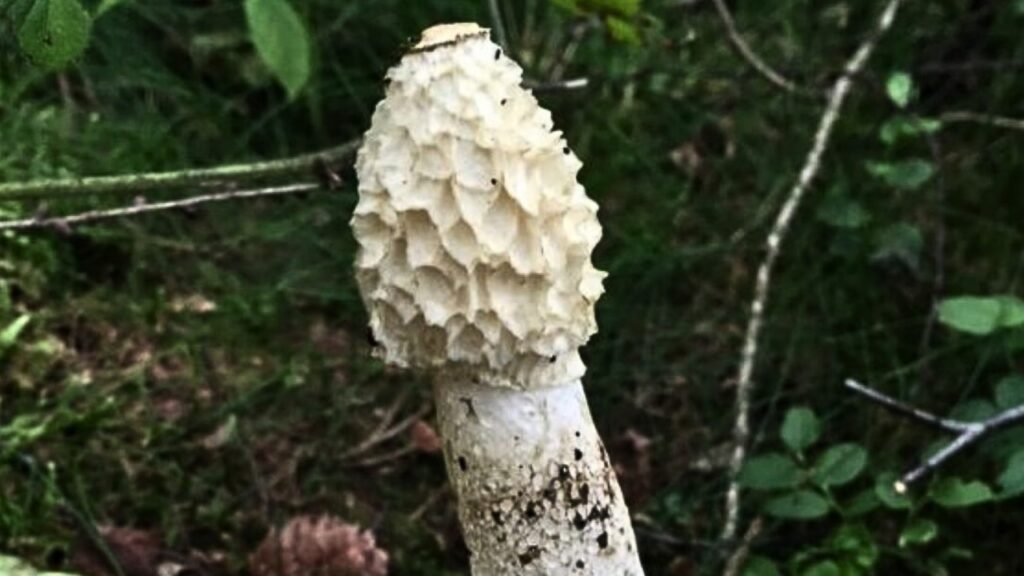
Yep, you can stop giggling at the back of the class because all your suspicions are correct. The name says it all; this thing both stinks and looks a lot like a certain part of the human anatomy. The stinkhorn mushroom, scientifically known as Phallus impudicus, is a truly unique and remarkable fungus that draws attention with its distinctive appearance, and as the name suggests, its unpleasant odor.
This fascinating mushroom belongs to the family Phallaceae, and it’s known for its phallic shape, making it a subject of curiosity and intrigue. The stinkhorn mushroom starts life as a small egg-shaped structure emerging from the ground. The outer layer of the egg-like structure called the peridium, is often white or pale and may be covered in a slimy substance.
As the mushroom matures, the phallic structure emerges, growing rapidly to reach heights of up to eight inches or more—or at least that’s what it tells any potential partners it might meet at a nightclub. The mature stinkhorn mushroom is characterized by its phallic shape, with a tall, slender stalk topped by a cap-like head.
The cap is covered in a foul-smelling spore mass that emits a putrid odor, often likened to the smell of rotting flesh or feces. This distinctive odor is an important feature of this reproductive strategy, attracting flies and other insects that help disperse its spores. While the smell of this thing may be offensive to humans, it does serve an important ecological purpose.
The foul odor acts as a lure to carrion-eating insects such as flies, which become covered in spores as they feed on the mushroom. These insects will then carry the spores to new locations, aiding in the dispersion and reproduction of this fungus. Despite that pungent odor.
The stinkhorn mushroom is not harmful to humans or animals, although it’s not typically consumed for fairly obvious reasons. However, in some cultures, it has been used in traditional medicine for various purposes, including treating skin conditions and digestive disorders.
08: Earth Star Fungus
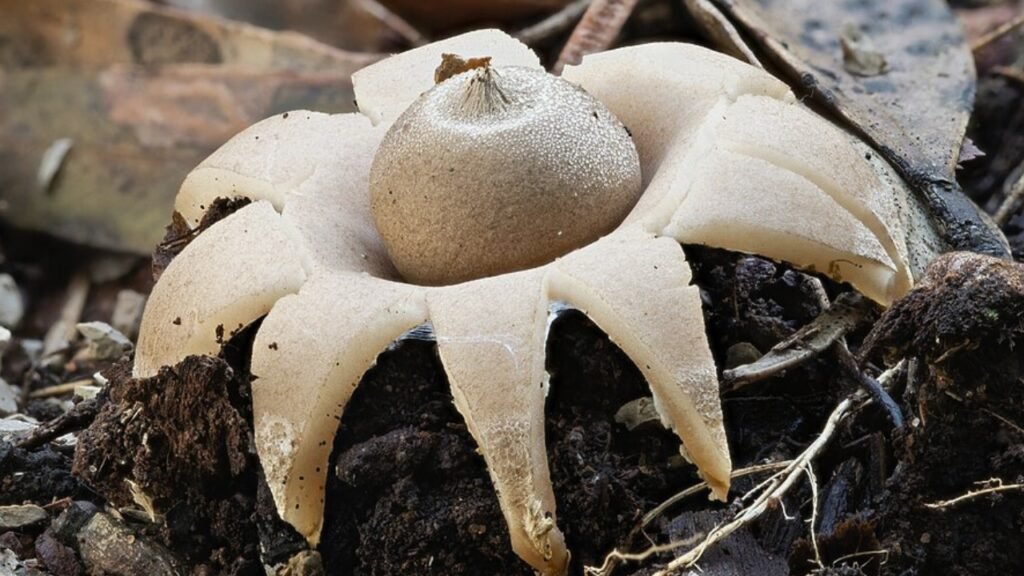
Well, perhaps the most sci-fi-sounding fungus on our list, Earthstar fungus, belonging to the family Geastraceae, is a captivating and peculiar group of fungi known for their unique appearance and fascinating life cycle. Characterized by star-shaped fruiting bodies, which consist of an outer layer and an inner spore-bearing structure.
The Earthstar fungi are found in various regions across the globe, often growing in forested areas or woodland habitats. They’re typically found on the ground, emerging from leaf litter, soil, or decaying wood. The fruiting body starts as a closed spherical structure, often resembling an egg or a puffball. Then, as it matures.
The outer layer splits open, revealing the inner spore sac, which expands and forms a star-like shape. This star-like structure of the Earthstar fungus serves multiple functions. When closed, it protects the developing spores inside, and as the outer layer splits open, it creates a cup-like structure that elevates that spore sac, allowing better dispersal of the spores.
The spores are released through an opening at the top of the spore sack, and they can be carried away by the wind or dispersed by animals and insects. The colors of an Earthstar fungus vary depending on the species, ranging from shades of brown and tan to vibrant reds and oranges. Some species have a velvety or fuzzy texture on the outer layer, adding to their unique and visually appealing appearance.
While Earthstar fungi are not typically consumed by humans, they play a crucial ecological role. They are part of the decomposition process, breaking down organic matter and recycling nutrients back into the soil. They also provide habitat and food sources for various organisms, including insects and, of course, other fungi.
Read More: Weird Islands Across the Globe!
07: Blue Stain Fungus

Yep, another fungus, another unpleasant-sounding name. After all, the word “stain” is never used to describe anything nice, is it? Blue stain fungus, scientifically known as Ophiostoma, is a group of fungi that play a significant role in the degradation and discoloration of wood.
These fungi are notable for their ability to cause blue staining in various types of timber, often leading to aesthetic and economic concerns in the forestry and construction industries. The blue stain fungus primarily infects living trees through wounds or openings created by bark beetles or other wood-boring insects.
Once inside the tree, the fungi colonize the wood and produce enzymes that break down the cell walls, allowing them to extract nutrients. As a result, the wood fibers become discolored, turning a distinct blue or grayish hue. The blue staining is caused by pigments produced by the fungi during the degradation process.
These pigments, known as melanins, give the infected wood its characteristic color. While the staining may appear unsightly, it doesn’t necessarily affect the structural integrity of the wood. However, the presence of the blue-stained fungus can have significant consequences for the forest industry.
Infected trees may be deemed less valuable due to the visual impairment caused by the blue staining. In addition, the staining can impact the marketability of lumber and other wood products, as consumers often prefer wood that’s free from discoloration. Efforts to control or prevent the spread of blue-stained fungus tend to focus on minimizing the susceptibility of trees to bark beetle infestations.
Proper forest management practices, such as the removal of infested trees or the application of preventative treatments, can help mitigate the impact of these fungi on commercial timber. In natural ecosystems, however, blue stain fungus plays a vital ecological role in the decomposition process.
By breaking down wood, these fungi contribute to the nutrient cycle and the release of carbon and other organic compounds back into the environment. They also create habitat and food sources for various organisms, including insects and other decomposers.
06: The Cauliflower Mushroom
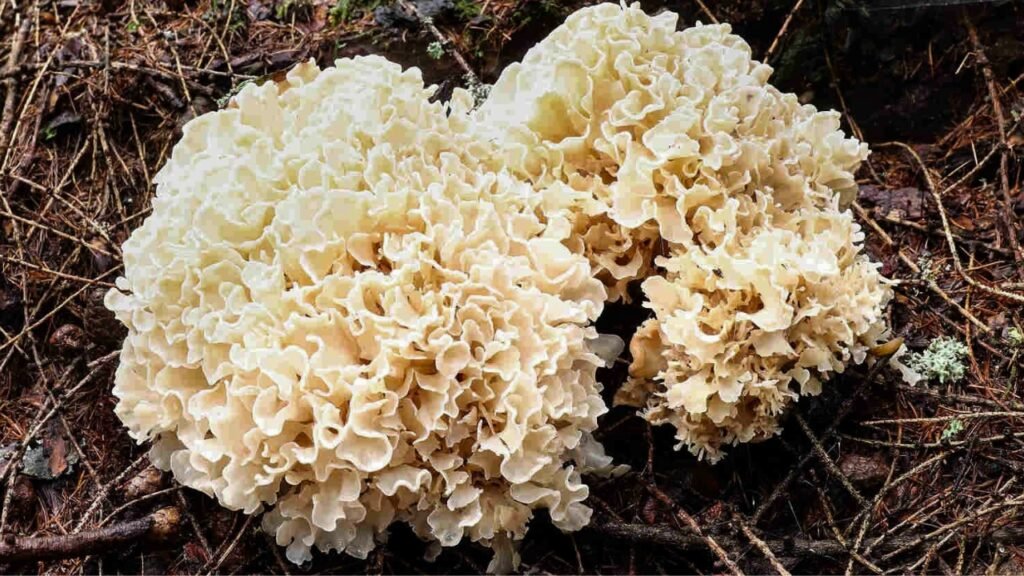
The cauliflower mushroom, scientifically known as Sparassis crispa, is a unique and visually striking fungus that bears a resemblance to its namesake vegetable. It’s known for its distinct appearance, culinary value, and interesting ecological role. The cauliflower mushroom is found in various parts of the world.
Typically in forested areas with coniferous or hardwood trees, and grows as a large irregularly shaped mass with multiple branches that branch out in a cauliflower-like pattern. These branches are pale to creamy white, forming a convoluted and frilly structure that can span several inches or more.
Aside from its eye-catching appearance, the cauliflower mushroom is highly regarded for its culinary qualities. It has a mild and nutty flavor with a tender yet firm texture. The mushroom’s unique shape and texture make it a versatile ingredient in various dishes, including stir-fries, soups, and pasta dishes.
It absorbs flavors well and complements a wide range of ingredients, making it a favorite among chefs and mushroom enthusiasts. In terms of ecology, the cauliflower mushroom plays an important role in forest ecosystems. It’s a saprophytic fungus, meaning it obtains nutrients by decomposing dead organic matter, particularly the roots of trees.
By breaking down decaying plant material, it contributes to nutrient recycling and helps facilitate the cycle of life in forest ecosystems. Its unique appearance and culinary potential make it a sought-after find, both for its visual appeal and its delectable taste.
05: Amethyst Deceiver

Now, this may sound like a personality characteristic rather than a description of a mushroom, but believe it or not, the name does sum up what this thing does pretty well. The amethyst deceiver, scientifically known as Laccaria amethystina, is a captivating and visually striking mushroom that’s known for its vibrant purple coloration and deceptive appearance.
Typically growing in association with trees, particularly in deciduous and coniferous forests, it features a convex or bell-shaped cap with a smooth surface, the color of which can vary from a rich purple hue to lilac or pinkish tones and can change and fade with age or environmental conditions.
And this, ladies and gentlemen, is where that name comes from because what sets the amethyst deceiver apart is its deceptive nature. Despite its vibrant appearance, this mushroom is known for its ability to blend seamlessly with its surroundings, making it difficult to spot. Its coloration allows it to camouflage among fallen leaves and mosses, evading detection by potential predators or foragers.
While the amethyst deceiver is not widely considered edible, it’s not toxic either. Its taste is mild, and the mushroom is often deemed as lacking desirable culinary qualities. However, it occasionally is included in mushroom pours and used in recipes that call for its striking appearance rather than its taste. In addition to its visual appeal, the amethyst deceiver plays a role in forest ecosystems. It forms mycorrhizal associations with tree roots, exchanging nutrients and aiding in the overall health of the forest.
Encountering the amethyst deceiver in the wild is a magical experience for any mushroom hunter. Its striking coloration and elusive nature remind us of the wonders and mysteries of the natural world, where even the most vibrant and beautiful organisms can be masters of disguise.
04: Bird’s Nest Fungus

Bird’s nest fungus, scientifically known as Cyathus, is a fascinating group of fungi that gets its name from its unique and distinctive appearance. These tiny fungi resemble miniature birds’ nests, complete with eggs inside, and can be found in various habitats around the world.
The fruiting body of the bird’s nest fungus consists of a cup-shaped structure called the peridium, which resembles a nest. This peridium is typically small, ranging from a few millimeters to a few centimeters in diameter. Inside the peridium, a small spore-containing structure called peridioles is present, resembling tiny eggs in a nest.
These peridioles are attached to the inner wall of the peridium by delicate threads. The unique shape and structure of a bird’s nest fungus serve a vital purpose in reproduction. When raindrops or water splashes hit the peridium, it creates a force that ejects the peridioles out of the cup-like structure.
The peridioles are then dispersed into the environment, ensuring the spread of fungus to new areas. This fungus is commonly found in forested areas, especially in decaying wood or leaf litter. They thrive in moist conditions, and their presence is often associated with decomposition processes.
These fungi play an essential role in nutrient recycling, breaking down organic matter, and contributing to the overall health of the forest ecosystem. Despite their diminutive size, bird’s nest fungi have captivated the interests of nature enthusiasts and photographers. Their intricate and delicate structures resembling nests cradling tiny eggs make for captivating subjects in macro photography.
03: Dead Man’s Fingers
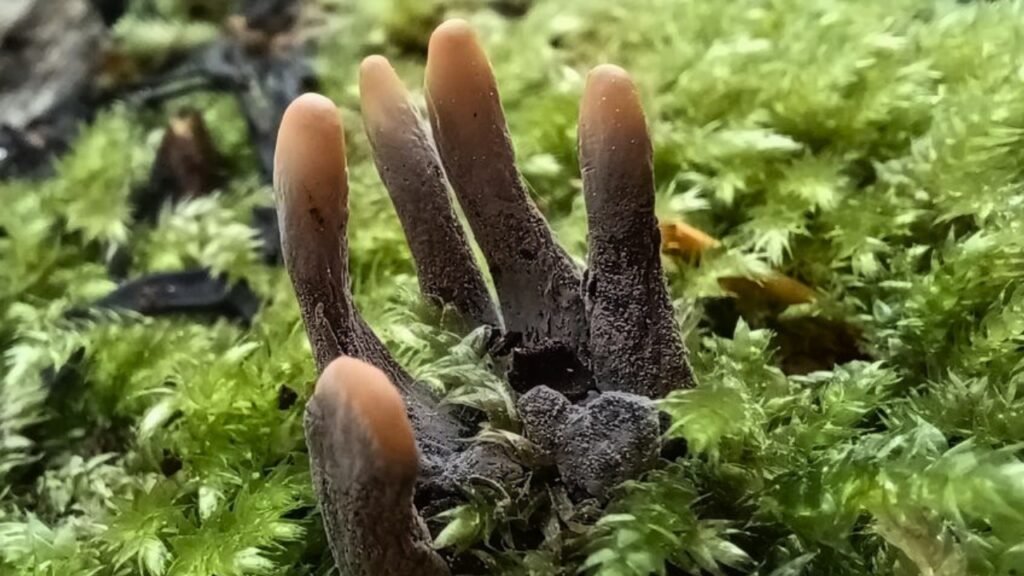
Alright, more fingers. Yep, we’re back to horror movies again, although this one could also double up as the title of a Pirates of the Caribbean sequel. Dead man’s fingers, scientifically known as Xylaria polymorpha, is a fungus that earns its name from its eerie resemblance to charred, blackened fingers emerging from the ground.
This distinctive and somewhat repulsive appearance has made it an interesting subject for nature lovers and photographers. Found in forests around the world, dead man’s fingers typically grow on decaying wood, especially on fallen trees or stumps. The fungus starts as a small, finger-like structure that gradually elongates and branches out, resembling the skeletal remains of human fingers reaching up from the forest floor.
That dark charcoal color adds to its uncanny resemblance, giving its presence an air of mystery. Despite its sinister appearance, though, dead man’s fingers play an essential role in the ecosystem. They are rotting, and break down organic matter, and recycling nutrients back into the environment.
By feeding on dead wood, they contribute to the natural process of decay and play a crucial role in forest nutrient cycles. Dead man’s toes are not harmful to humans or animals and pose no real danger. However, their unique appearance has given rise to various myths and superstitions throughout history.
In folklore, they’ve been associated with death and the supernatural, adding to their mystique and capturing the imagination. Encountering dead man’s fingers in the wild can be a captivating experience. The sinister shape and dark color create a striking contrast against the natural surroundings.
However, it is important to appreciate them in their natural habitat and avoid disturbing or collecting them, allowing these fascinating fungi to fulfill their ecological role without interruption. Their haunting appearance and role in the cycle of life and death make them a prime example of nature’s ability to create both beauty and intrigue in unexpected forms.
02: Bleeding Tooth Fungus
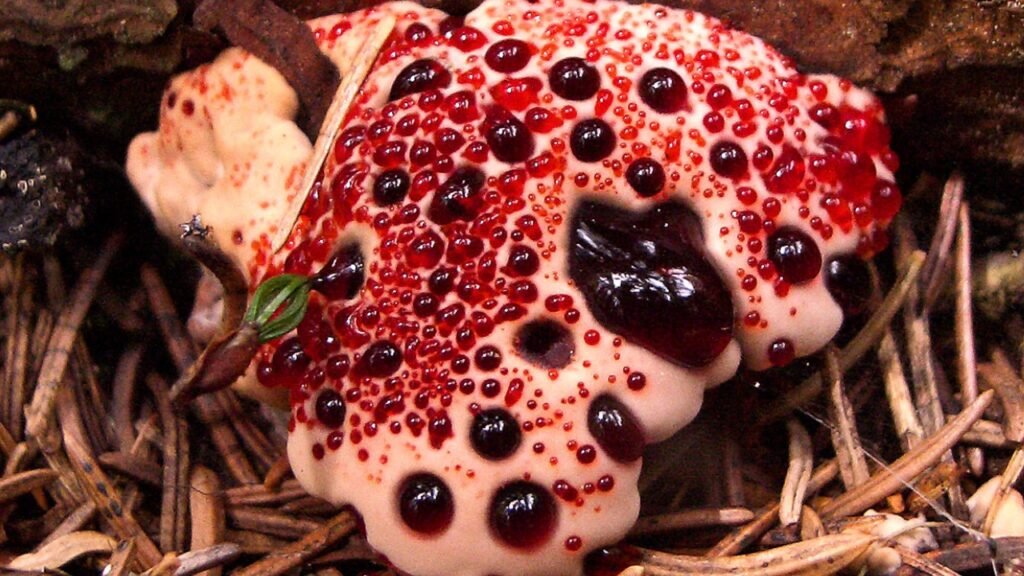
Brace yourself, fungus fans, because the sickening names just keep coming. And as if some of these names weren’t bad enough, we’re now going to keep saying a phrase that instantly makes you think of a visit to the dentist: the bleeding tooth fungus, scientifically known as Hydnellum peckii, is a peculiar and captivating fungus that stands out with its unique and unsettling appearance.
Found in various parts of North America, Europe, and Asia, this fungus gets its common name from its remarkable ability to exude a red fluid that resembles blood, earning it a reputation as one of the most unusual and intriguing fungi in the world. Bleeding tooth fungus is easily recognizable by its spiky, tooth-like projections that cover its cap and stem.
The fungus starts with a pale off-white or beige color, but as it matures, the tips of the spines turn a deep red and begin to ooze a blood-like substance. This fluid is not actual blood, of course, but a pigmented liquid that contains various compounds, including pigments and anticoagulant properties. The purpose of this bleeding phenomenon is still not fully understood.
Some theories suggest that the red fluid may act as a deterrent to potential predators, while others propose that it may aid in attracting insects for dispersal. Regardless of the exact function, the bleeding feature adds an eerie and captivating element to the bleeding tooth fungus.
Despite its unsettling appearance, the fungus is not harmful to humans or animals. It serves a vital ecological role as a decomposer. Like other fungi, it feeds on decaying organic matter, assisting in the breakdown and recycling of nutrients in the forest ecosystem. As with many other fungi on our list, it’s important to leave these things undisturbed, which is probably the exact opposite advice we’d be giving you if you had bleeding teeth.
01: Dog Vomit Slime Mold
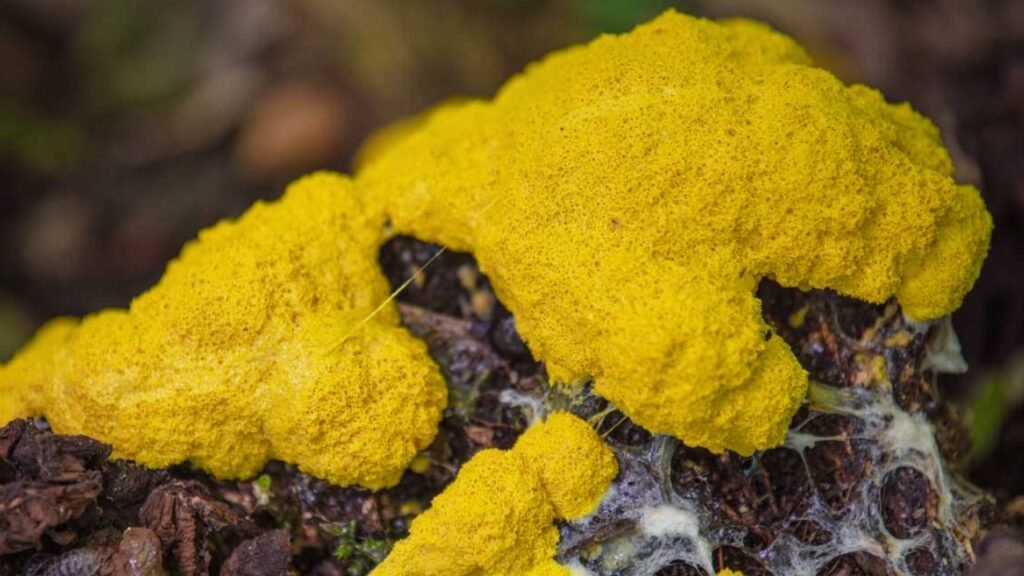
Well, I saved the worst for last. Could any of the names of the fungi we’ve discussed so far be quite as unpleasant as this one? And yes, once more, it does look like the thing it’s named after: the dog vomit slime mold, scientifically known as Fuligo septica, is a fascinating and somewhat repulsive organism that captures attention with its peculiar appearance and intriguing life cycle.
Despite its unappealing name, however, this unique slime mold plays an important ecological role and offers valuable insights into the complexity of nature. Dog vomit slime mold typically appears as a bright yellow or orange mass resembling regurgitated dog food or, as its name suggests, dog vomit. It can be found in damp, shady areas such as forest floors, decaying wood, or mulch, initially presenting as a gelatinous substance but transforming as it matures into a powdery or crusty texture.
The life cycle of the dog vomit slime mold is truly remarkable. It starts as individual cells that come together and merge to form a larger multicellular organism known as plasmodium. This plasmodium is often spread over several square feet, engulfing organic matter as it moves, feeding on bacteria, fungi, and other organic material—a feeding process that is an essential part of its ecological role as a decomposer.
As the plasmodium reaches maturity, it transforms and stops feeding, migrates to a suitable location, and eventually transforms into massive spore-bearing structures. These structures release spores into the environment, which can be dispersed by winds, insects, or other means. These spores then germinate and begin the cycle anew.
Although the dog vomit slime mold may not be visually appealing, it plays a vital role in nutrient recycling and decomposition processes. By breaking down dead plant material and organic matter, it contributes to the ecosystem’s balance and helps release nutrients back into the soil, promoting the growth of new life. In other words, it’s not anywhere near as disgusting as the real stuff.

